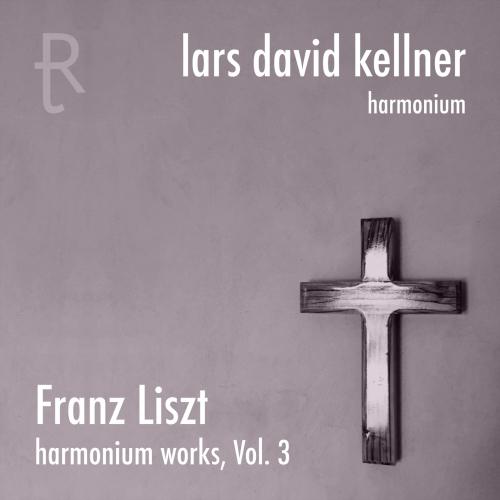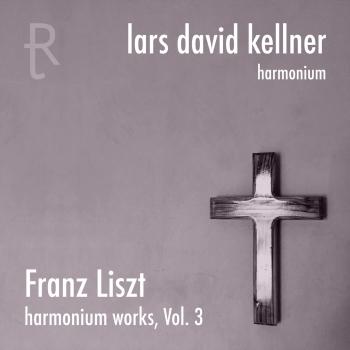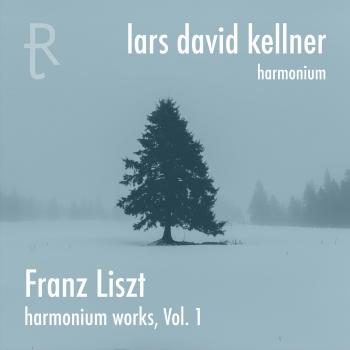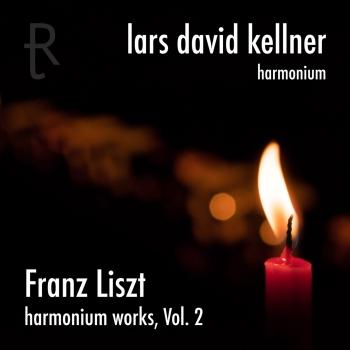
Franz Liszt: Harmonium Works Vol. 3 Lars David Kellner
Album info
Album-Release:
2021
HRA-Release:
14.12.2021
Label: recordjet
Genre: Classical
Subgenre: Chamber Music
Artist: Lars David Kellner
Composer: Franz Liszt (1811-1886)
Album including Album cover Booklet (PDF)
- Franz Liszt (1811 - 1886): Via Crucis, S. 669b:
- 1 Via Crucis, S. 669b: Vexilla Regis 04:13
- 2 Via Crucis, S. 669b: I. Jésus est condamné à mort 01:24
- 3 Via Crucis, S. 669b: II. Jésus est chargé de la Croix 02:31
- 4 Via Crucis, S. 669b: III. Jésus tombe pour la première fois 01:55
- 5 Via Crucis, S. 669b: IV. Jésus rencontre sa très sainte Mère 02:35
- 6 Via Crucis, S. 669b: V. Simon le Cyrénéen aide Jésus à porter sa Croix 02:41
- 7 Via Crucis, S. 669b: VI. Sancta Veronica 02:41
- 8 Via Crucis, S. 669b: VII. Jésus tombe pour la seconde fois 01:58
- 9 Via Crucis, S. 669b: VIII. Les Femmes de Jérusalem 02:41
- 10 Via Crucis, S. 669b: IX. Jésus tombe une troisième fois 01:52
- 11 Via Crucis, S. 669b: X. Jésus est dépouillé de ses vêtements 02:20
- 12 Via Crucis, S. 669b: XI. Jésus est attaché à la Croix 00:53
- 13 Via Crucis, S. 669b: XII. Jésus meurt sur la Croix 07:11
- 14 Via Crucis, S. 669b: XIII. Jésus est déposé de la Croix 04:13
- 15 Via Crucis, S. 669b: XIV. Jésus est mis dans le sépulcre 05:36
Info for Franz Liszt: Harmonium Works Vol. 3
As far as Franz Liszt's compositional output for keyboard instruments is concerned, the virtuoso pianist and later cleric not only considered the piano, but also the organ: in addition to some smaller pieces, a handful of quite larger works exist specifically written for the church organ. A significant number of his late sacred compositions, however, are not conceived for only one particular keyboard instrument, but ‘works‘ - following Liszt's explicit indications - on various instruments: piano, organ or harmonium. These pieces must also be taken into account if one wants to fully penetrate the oeuvre of the master as an interpreter.
By systematically surveying the published complete recordings of Liszt's ‘organ works‘, it becomes clear that this very term is unfortunately understood in a one-sided - because all too literal - manner, since the performance of these pieces takes place without exception on the organ. A recording of all works that were written exclusively or alternatively for harmonium solo is not yet available. This production is intended to fill a remarkable gap and may restore the harmonium to its status as a fully-fledged keyboard instrument in the composer's sense.
As an instrumental soloist, the harmonium is an instrument that combines the tonal and technical advantages of piano and organ in a convincing manner: dynamic variability is accompanied by a sustained tone. Franz Liszt, too, will have been aware of these advantages when composing and playing the Via Crucis on his harmonium, when it was a matter of spanning slurs of epic length, of letting melodies first grow and then die away again - in the sense of a true ‘smorzando‘. Seen in this light, the harmonium is probably the instrumental means of first choice for the majority of Liszt's sacred late works for keyboard instruments.
Lars David Kellner, harmonium
Lars David Kellner
Lars David Kellner's CD recordings include a number of bravura pieces for piano literature: Modest Mussorgsky's Pictures at an Exhibition is one of them (published 2010), as well as sonatas and ballads by Sergei Rachmaninoff or Frédérik Chopin (2008). However, Kellner sees himself not only as a virtuoso pianist, but rather as a (keyboard) artist in a broader sense: in addition to the piano, the harmonium has been of special importance to him for some years now. With many premiere recordings he is making an active contribution to the revitalization of this special keyboard instrument. The artist's latest album with solo works by Franz Liszt, which was released in 2020 on renowned audiophile portals, is recorded on a harmonium from Kellner's instrument collection. Kellner puts great importance to bringing his audience closer to lesser known compositions for unusual keyboard instruments in their very own sound language.
It is of utmost importance for the artist to penetrate musical works comprehensively. After meticulous study of the sources, Kellner recorded the complete piano works by Leoš Janáček in their earliest version. The publication of these sound recordings, new to the world of music, caused an international sensation: ‘He posseses a full-bodied and rounded sound and solid technique, making the hardest passages sound easy. (...) His freedom with the music (...) is exceptional’ (Fanfare Mag, 8/2014). Kellner's Mussorgski album with recordings on the Horowitz grand piano was also highly acclaimed in the American Record Guide: ‘Kellner (...) finds the inner voices and deals effectively with contrasts. He reminds me of Ashkenazy’ (ARG, 12/2011). The complete Pictures at an Exhibition were premiered by Kellner in their first version (2011). His piano recitals (e.g. at the Gasteig München) and concerts with harmonium and celesta were well received by the audience and caused wide media coverage.
Since the foundation of tastenReich® (2017) Lars David Kellner's chamber music collaboration with artists such as Jürgen Geiger, Anastasia Sobyanina and other keyboard virtuosos has intensified. His love for romantic songs led to intensive concert activity with singers like Susanna Proskura or Marina Ushchapovskaya. Lars David Kellner adapted the Russian lyrics of Rachmaninoff's fourteen "Lieder ohne Opuszahl" into German, in order to bring them closer to the local audience. They were published by Sikorski Musikverlage Hamburg in 2015.
Lars David Kellner, born in 1973 in Weiden/Germany, is a pianist with multiple diplomas from the Munich Academy of Music (2001) and lives in Bavaria. His musical education was accompanied by Franz Ondrušek, Erich Appel and Karl-Hermann Mrongovius. He received artistic inspiration from Eckart Besch, Klaus Schilde and Elza Kolodin at international master classes. Kellner is a member of the German Liszt Society, the Karg-Elert Society and is on the board of the Friends of the Weiden Max-Reger-Tage.
Booklet for Franz Liszt: Harmonium Works Vol. 3












